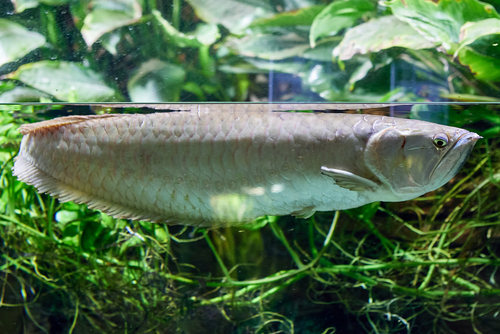Hailing from the Amazon River’s floodplains, the bony-tongued Silver Arowana is a large freshwater fish with glints of pink, yellow, or blue along its silver body. If you’ve chosen this species for your aquarium, you’re in luck, since this graceful fish is an underwater acrobat who hits it off with larger fish that can hold their own and live in different water columns in a communal tank.
Several Cichlid species, Plecos, Datnoids, Loaches, Mollies, big Catfish, and Parrot fish, and even Freshwater Stingrays harmonize well with the top water-column-feeding Arowana.
Find the right Silver Arowana tank mates from this detailed post.
Contents
What You Need to Know
Silver Arowanas tend to get along well with larger fish that are either placid or only mildly territorial. While they often have trouble harmonizing with their own species, they tend to stick to the upper water column and leave middle and bottom-dwellers alone.
The good news is that Silver Arowanas are usually flexible when it comes to fluctuations in water parameters. This means that they won’t feel stressed if you attune the water temperature, hardness or softness, and pH levels a little more to your more delicate fish.
At the same time, this doesn’t mean that aquarists should play hard and fast with water measurement rules. You’ll want to ensure that the parameters fall into these standard ranges to give your Arowanas the best success rate:
- Water temperature between 75°F-82°F.
- pH: Between 5.0-7.5
- Water hardness: 1-8 dKH
The 15 Best Silver Arowana Tank Mates
You will also like these other popular posts in this category:
- Swordtail Tank Mates
- Odessa Barb Tank Mates
- Scarlet Badis Tank Mates
- Celestial Pearl Danio Tank Mates
1. Blood Parrot Fish
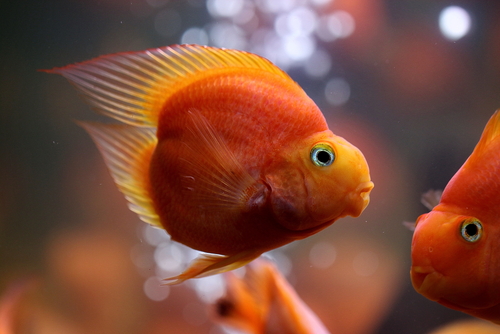
- Scientific name: Amphilophus citrinellus
- Origin: Throughout South and Central America
- Size: 4.9 inches
- Care level: Medium
This medium size, flaming orange fish belongs to a hybrid cichlid species that is decorated with tiny white scales.
With a placid nature, this fish stays active and likes to spend time darting around the aquarium when it isn’t hiding under rocks or plants. The best water temperature for Parrot Fish falls between 75-80 degrees F.
Pros of keeping with Silver Arowana
- Top-notch tank cleaners
Cons of keeping with Silver Arowana
Eat lots of food and make lots of waste
2. Silver Dollar Fish
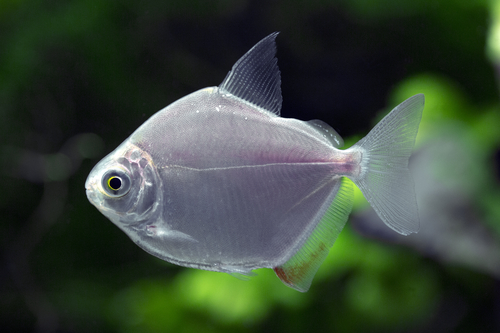
- Scientific name: Metynnis argenteus
- Origin: Brazil
- Size: 5 or 6 inches
- Care level: Medium
Silver Dollar fish are a schooling species that harmonize well with Arowanas. They have discus-shaped bodies like the silver coins that give them their name.
These gentle fish need a larger tank if you plan to keep a school of a minimum of five fish along with an Arowana. They appreciate multiple tank ornaments, plants, and rocks for handy hiding spots.
While these fish aren’t hard to feed, a school does produce tons of waste, so consider investing in a good filtration system to keep your tank sparkling clean.
Pros of keeping with Silver Arowana
- Hardy, active, and schooling
Cons of keeping with Silver Arowana
- Require a lot of space in a larger tank
3. Bristlenose Pleco
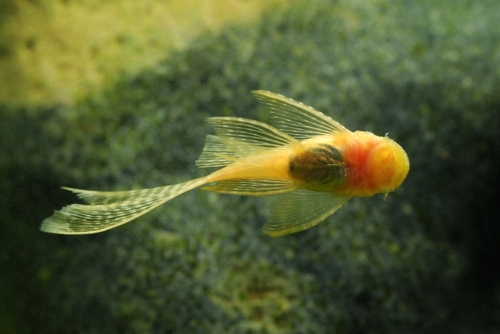
- Scientific name: Ancistrus cirrhosus
- Origin: Panama
- Size: 6 inches
- Care level: Medium
In case you didn’t know, the Bristlenose Pleco is actually a kind of catfish. These placid creatures are slow bottom-dwellers who spend their time pressing their lips against the glass at the bottom of the tank.
Since they are slow-moving loners, they won’t bother your Arowanas at the top of the tank at all. At the same time, Plecos do better with large tanks to offset the amount of waste that they produce.
Pros of keeping with Silver Arowana
- Bottom-feeders who clean the tank
Cons of keeping with Silver Arowana
- Require a lot of food and more frequent water changes due to lots of waste
4. Tiger Datnoid
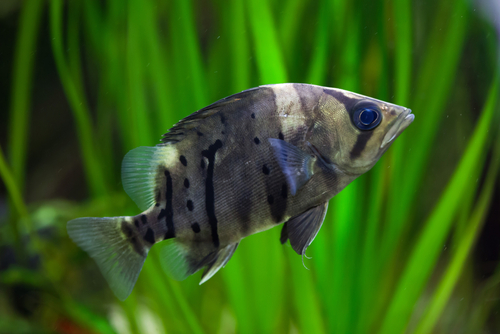
- Scientific name: Datnioides microlepis
- Origin: Papua New Guinea and Indonesia
- Size: 10 inches
- Care level: Moderate
You might know this Datnoid as a Tiger Fish because it carries dark stripes on its white and gold scales. When not in their indigenous habitat, Tiger Fish enjoy a carnivorous diet of live shrimp and worms, although they can also eat regular fish foods.
These fish tend to grow big, with a few getting over a foot long. The good news is that they’re shy beings who won’t get in Arowana’s way since they’ll probably just hide under a rock or in a cave at the bottom of the aquarium.
Pros of keeping with Silver Arowana
- Placid and interesting
Cons of keeping with Silver Arowana
- May succumb to various fin and eye issues
5. Kuhli Loach
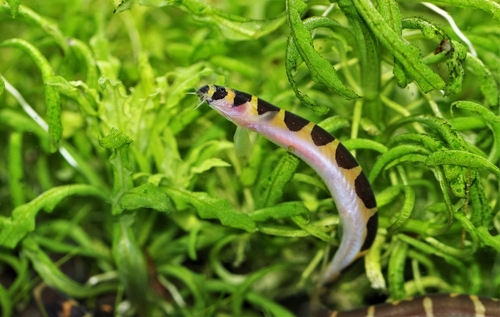
- Scientific name: Pangio kuhlii
- Origin: Island of Java
- Size: Over 3 inches
- Care level: Medium
Kuhli Loaches are nocturnal fish that hide in caves or rocks like brown and yellow eels at the bottom of the tank. Since they are slow, have a different kind of sleep cycle, and stay on the tank floor, they won’t come into contact with the more active Arowana in the upper column.
At night, these placid fish can entertain by getting together at night and flitting around the tank.
Pros of keeping with Silver Arowana
- Known for being a tank janitor
Cons of keeping with Silver Arowana
- Tends to get infections and diseases
6. Black-Ghost Knife Fish
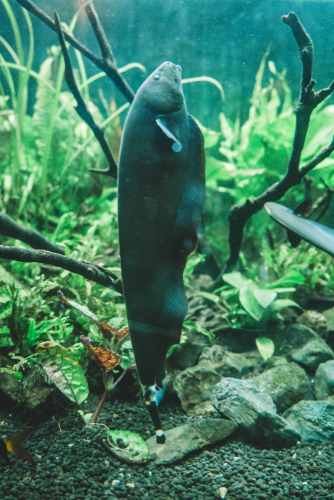
- Scientific name: Apteronotus albifrons
- Origin: Paraguay and Venezuela
- Size: 19 inches
- Care level: Medium to difficult
These cool, blade-shaped fish come from across the African, Asian, and South American continents. With its sharp, knife shape, this fish can also swim backward which can make them fascinating additions to any community tank.
While they can get a little aggressive towards smaller species, they don’t tend to bother Arowanas who can hold their own in an aquarium. Because they can grow super long, Knife Fish require up to a 200-gallon tank.
Pros of keeping with Silver Arowana
- Active and interesting
Cons of keeping with Silver Arowana
- Sometimes predatory to tinier fish and need strict water measurements
7. Iridescent Shark Fish
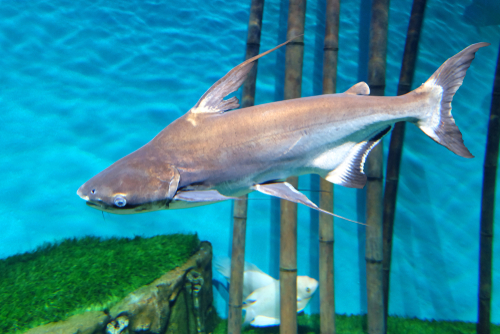
- Scientific name: Pangasianodon hypophthalmus
- Origin: Asia
- Size: Up to 3 feet long in the wild (smaller in tanks)
- Care level: Difficult
Before you think that you’re getting a real aquarium shark, it’s important to recognize that the Iridescent Shark Fish is really a breed of catfish. It is a shimmering gray color and has long barbels that dangle near its mouth like other catfish cousins.
This species inhabits the middle of the tank, so it doesn’t have a problem sharing space with Arowanas above it. Keep in mind that these pseudo-sharks are schooling fish, so you’ll need to keep a couple together, which means that you’ll need a 200-300-gallon tank to accommodate them.
Pros of keeping with Silver Arowana
- Not predatory despite its name
Cons of keeping with Silver Arowana
- Needs a huge tank
8. Black Molly
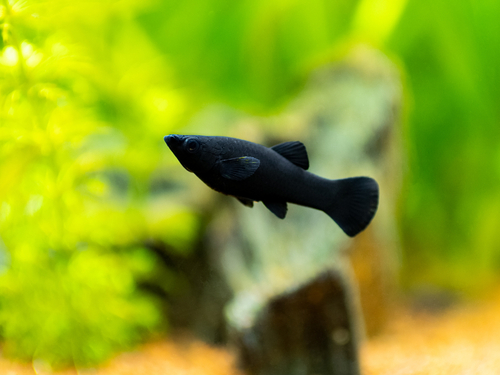
- Scientific name: Poecilia sphenops
- Origin: Mexico and South America
- Size: 4 inches
- Care level: Beginner
Mollies are black in color but can come in a lot of different colors and patterns that can add an interesting touch to your tank.
These active fish tend to eat their own young, so if they reproduce, make sure you place the fry in a separate tank. On most occasions, Mollies will eat both frozen pellets and live treats.
Pros of keeping with Silver Arowana
- Great at removing algae from the tank
Cons of keeping with Silver Arowana
- Can get stressed and hostile in too small a tank
9. Firemouth Cichlid

- Scientific name: Thorichthys meeki
- Origin: Belize and Mexico
- Size: Around 5 inches
- Care level: Beginner
A good tank mate for an Arowana is the Firemouth Cichlid. It’s peaceful when left alone in a tank full of rocks and plants where it usually spends time near the middle and bottom substrate.
Their water parameters are similar to the Arowana, so you can keep them at the same temperature range easily. These fish keep to themselves where they often move around the tank rearranging plants and ornaments.
Pros of keeping with Silver Arowana
- Don’t require a big tank
Cons of keeping with Silver Arowana
- Need strict water measurements
10. Clown Loach
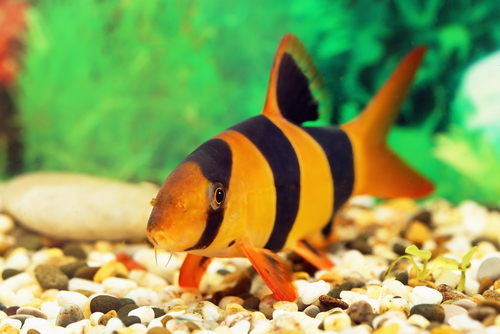
- Scientific name: Chromobotia macracanthus
- Origin: Borneo
- Size: About 7 inches
- Care level: Moderate
A Clown Loach will drift around the bottom of the tank so it won’t cross paths very much with an Arowana. Aim to keep around 6 Loaches together to keep them better behaved and observe their more social behavior.
Like many lower-dwelling fish, they like a tank that has some shady plants, and lots of rocks for hiding places. They have stricter water parameters than some, so it’s important to adjust the water correctly.
Pros of keeping with Silver Arowana
- Placid schooling fish
Cons of keeping with Silver Arowana
- Need larger tanks
11. Freshwater Stingray
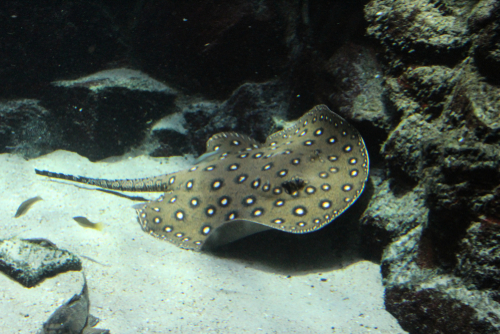
- Scientific name: Potamotrygon motoro
- Origin: South and Central America
- Size: 17 inches
- Care level: Expert
This round-bodied patterned Stingray is in reality the biggest freshwater fish. Although they are placid towards other fish and keep to themselves, they can give humans a nasty sting with their barbed tails when threatened. It’s possible to train stingrays to eat from the hand safely since they are interactive creatures once taught.
These mysterious flat fish are also called “peacock eyes” for their interesting patterns. They wait for their food to come to them as they lie at the bottom of the tank under a fine substrate of sand. Aim to keep the tank parameters from 75 to 82 °F for temperature and pH at 6.8 to 7.6.
Pros of keeping with Silver Arowana
- Interesting and in-demand as tank companions
Cons of keeping with Silver Arowana
- Need strict parameters and fine substrate
12. Flying Fox Fish
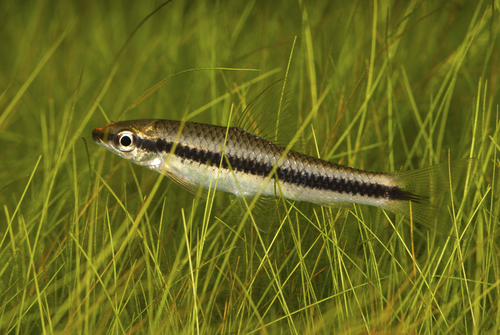
- Scientific name: Epalzeorhynchos kalopterus
- Origin: Malay, Sumatra, and Borneo
- Size: About 5 inches
- Care level: Easy
This fish comes from the Indonesian area and needs a 100-gallon tank to give it enough room to swim. It also enjoys a gravel substrate with vegetation and stones to mimic its river habitat in the wild.
Flying Fox Fish are omnivores who can consume anything from cooked veggies to frozen tidbits and algae pellets
Pros of keeping with Silver Arowana
- Good algae eaters
Cons of keeping with Silver Arowana
- Can get territorial towards males of its own species
13. Pacu Fish
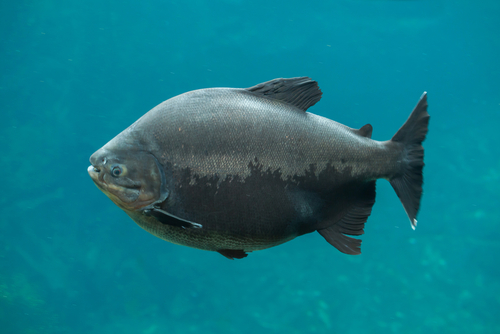
- Scientific name: Colossoma macropomum
- Origin: South America
- Size: About 2 feet in length
- Care level: Intermediate
A Pacu is a cousin to the Piranha, but thankfully this fish won’t bite you or rip its tank mates apart. It is a schooling fish when young and a loner as an adult. They can nibble on other fish if they feel stressed from a small tank or the other fish has longer, flapping fins.
Since the Pacu’s tank conditions fall into the same range as the Arowana, this makes them an easy and compatible companion.
Pros of keeping with Silver Arowana
- Large enough to hold its own, but non-predatory
Cons of keeping with Silver Arowana
- Needs a 200-gallon tank per adult fish and 300-gallon tank to hold additional fish
14. Oscar Fish
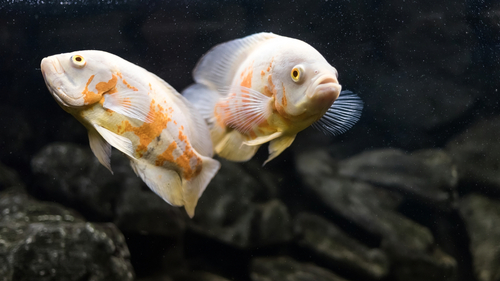
- Scientific name: Astronotus ocellatus
- Origin: Paraguay
- Size: 11 inches
- Care level: Fairly difficult
An Oscar Fish is a perfect tank mate for a Silver Arowana since it is large enough to defend itself against bigger fish and has a mellow personality.
A couple of things that make this species challenging to care for include having a heater to get tank temperatures between 74 to 81 °F degrees, weekly water changes, and a diet that’s high in protein.
Pros of keeping with Silver Arowana
- Intelligent and trainable
Cons of keeping with Silver Arowana
- Needs lots of nutrients and frequent cleaning due to bioload
15. Green Terror Cichlid
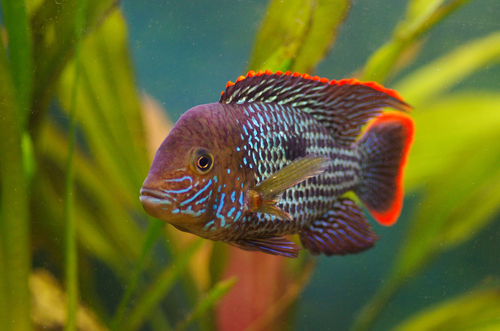
- Scientific name: Andinoacara rivulatus
- Origin: Ecuador
- Size: 13 inches
- Care level: Beginner
Far from being a terror (except for smaller fish in a crowded tank), this cichlid is a fascinating fluorescent shade that shifts from blue to green colors. Since these fish produce a big bio-load, it’s essential to get at least a 100-gallon tank with a canister filtration system.
Pros of keeping with Silver Arowana
- Active and fun to watch with LED lights at night
Cons of keeping with Silver Arowana
- Can get territorial with smaller-size fish or other male cichlids
Conclusion
Now that you have a good idea about the 15 best Silver Arowana Tank Mates to try, it’s time to choose your fish.
Once you decide which fish you want, you’ll need to ensure that you have a water testing kit on hand to ensure that more sensitive species have the right water parameters to survive and thrive. It’s also important to consider what size tank you’ll need for the number of fish involved.
Try to add fish one at a time to help them get used to their new friends and have fun with the interplay of fins and personalities.
FAQs
How Many Silver Arowanas Can Live in a Tank Together?
Arowanas can get aggressive towards their own species. Since they aren’t schooling fish, it’s usually best to just keep a single Arowana in a tank. Experienced aquarists can determine which types of Arowanas do well together. It’s recommended to keep only a few females with a single male Arowana if you do want to try to keep several in the same tank.

Ian Sterling, founder of Fishlab.com, began his aquarium journey over 30 years ago, driven by a deep fascination for fish and their diverse personalities. His website, Fishlab.com, is dedicated to making fishkeeping accessible and enjoyable, offering beginner-friendly guidance, expert insights, and a community for aquarists to connect and share experiences.


